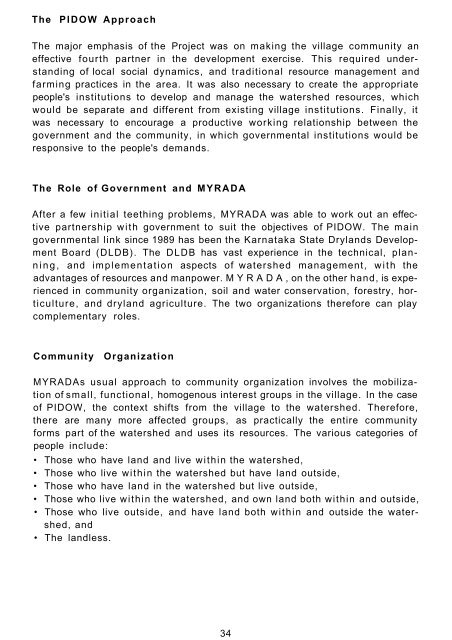Indigenous Practices for Soil and Water Conservation - Agropedia
Indigenous Practices for Soil and Water Conservation - Agropedia
Indigenous Practices for Soil and Water Conservation - Agropedia
Create successful ePaper yourself
Turn your PDF publications into a flip-book with our unique Google optimized e-Paper software.
The PIDOW Approach<br />
The major emphasis of the Project was on making the village community an<br />
effective fourth partner in the development exercise. This required underst<strong>and</strong>ing<br />
of local social dynamics, <strong>and</strong> traditional resource management <strong>and</strong><br />
farming practices in the area. It was also necessary to create the appropriate<br />
people's institutions to develop <strong>and</strong> manage the watershed resources, which<br />
would be separate <strong>and</strong> different from existing village institutions. Finally, it<br />
was necessary to encourage a productive working relationship between the<br />
government <strong>and</strong> the community, in which governmental institutions would be<br />
responsive to the people's dem<strong>and</strong>s.<br />
The Role of Government <strong>and</strong> MYRADA<br />
After a few initial teething problems, MYRADA was able to work out an effective<br />
partnership with government to suit the objectives of PIDOW. The main<br />
governmental link since 1989 has been the Karnataka State Dryl<strong>and</strong>s Development<br />
Board (DLDB). The DLDB has vast experience in the technical, plann<br />
i n g , <strong>and</strong> implementation aspects of watershed management, w i t h the<br />
advantages of resources <strong>and</strong> manpower. M Y R A D A , on the other h<strong>and</strong>, is experienced<br />
in community organization, soil <strong>and</strong> water conservation, <strong>for</strong>estry, horticulture,<br />
<strong>and</strong> dryl<strong>and</strong> agriculture. The two organizations there<strong>for</strong>e can play<br />
complementary roles.<br />
Community<br />
Organization<br />
MYRADAs usual approach to community organization involves the mobilization<br />
of small, functional, homogenous interest groups in the village. In the case<br />
of PIDOW, the context shifts from the village to the watershed. There<strong>for</strong>e,<br />
there are many more affected groups, as practically the entire community<br />
<strong>for</strong>ms part of the watershed <strong>and</strong> uses its resources. The various categories of<br />
people include:<br />
• Those who have l<strong>and</strong> <strong>and</strong> live within the watershed,<br />
• Those who live within the watershed but have l<strong>and</strong> outside,<br />
• Those who have l<strong>and</strong> in the watershed but live outside,<br />
• Those who live within the watershed, <strong>and</strong> own l<strong>and</strong> both within <strong>and</strong> outside,<br />
• Those who live outside, <strong>and</strong> have l<strong>and</strong> both within <strong>and</strong> outside the watershed,<br />
<strong>and</strong><br />
• The l<strong>and</strong>less.<br />
34

















